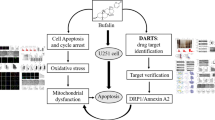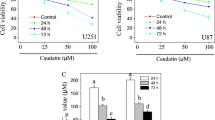Abstract
Glioma remains the leading cause of brain tumor–related death worldwide. Apoptosis inducing factor (AIF) is a family of mitochondrial oxidoreductases that play important roles in mitochondrial metabolism and redox control. AIF-1 has been demonstrated to exert cell-killing effect via apoptosis in cancer cells, whereas the role of AIF-2 in cancer cells has not been determined. This study aimed to investigate the role of AIF-2 in human glioma cells. We found that AIF-2 was upregulated in human glioma tissues and cell lines, especially in U251 cells. Downregulation of AIF-2 using specific siRNA (Si-AIF-2) significantly reduced cell proliferation, induced G1 cell cycle arrest and differently regulated the expression of cell cycle regulator proteins in U251 cells. In addition, the results of Matrigel invasion assay and live-cell tracking assay showed that knockdown of AIF-2 inhibited cell invasion and migration. The results of immunocytochemistry indicated that knockdown of AIF-2 significantly attenuated the nuclear translocation of AIF-1, which was confirmed by western blot analysis. Furthermore, downregulation of AIF-2 resulted in mitochondrial dysfunction in U251 cells, as evidenced by reduced mitochondrial membrane potential (MMP), mitochondrial complex I activity, and mitochondrial Ca2+ buffering capacity. In conclusion, we found that AIF-2 plays a key role in promoting cell proliferation, invasion, and migration via regulating AIF-1-related mitochondrial cascades. Downregulation of the candidate oncogene AIF-2 might constitute a strategy to kill human glioma cells.




Similar content being viewed by others
References
Bano D, Prehn JHM (2018) Apoptosis-inducing factor (AIF) in physiology and disease: the tale of a repented natural born killer. EBioMedicine 30:29–37
Boussiotis VA, Charest A (2018) Immunotherapies for malignant glioma. Oncogene 37:1121–1141
Churbanova IY, Sevrioukova IF (2008) Redox-dependent changes in molecular properties of mitochondrial apoptosis-inducing factor. J Biol Chem 283:5622–5631
Cloughesy TF, Cavenee WK, Mischel PS (2014) Glioblastoma: from molecular pathology to targeted treatment. Annu Rev Pathol 9:1–25
Dai B, Hu Z, Huang H, Zhu G, Xiao Z, Wan W, Zhang P, Jia W, Zhang L (2014) Overexpressed KDM5B is associated with the progression of glioma and promotes glioma cell growth via downregulating p21. Biochem Biophys Res Commun 454:221–227
Fukami T, Nakasu S, Baba K, Nakajima M, Matsuda M (2004) Hyperthermia induces translocation of apoptosis-inducing factor (AIF) and apoptosis in human glioma cell lines. J Neuro-Oncol 70:319–331
Hangen E, De Zio D, Bordi M, Zhu C, Dessen P, Caffin F, Lachkar S, Perfettini JL, Lazar V, Benard J, Fimia GM, Piacentini M, Harper F, Pierron G, Vicencio JM, Benit P, de Andrade A, Hoglinger G, Culmsee C, Rustin P, Blomgren K, Cecconi F, Kroemer G, Modjtahedi N (2010) A brain-specific isoform of mitochondrial apoptosis-inducing factor: AIF2. Cell Death Differ 17:1155–1166
Huang ST, Bi KW, Kuo HM, Lin TK, Liao PL, Wang PW, Chuang JH, Liou CW (2014) Phyllanthus urinaria induces mitochondrial dysfunction in human osteosarcoma 143B cells associated with modulation of mitochondrial fission/fusion proteins. Mitochondrion 17:22–33
Jeong JC, Shin WY, Kim TH, Kwon CH, Kim JH, Kim YK, Kim KH (2011) Silibinin induces apoptosis via calpain-dependent AIF nuclear translocation in U87MG human glioma cell death. J Exp Clin Cancer Res 30:44
Lee JW, Jeong EG, Soung YH, Kim SY, Nam SW, Kim SH, Lee JY, Yoo NJ, Lee SH (2006) Immunohistochemical analysis of apoptosis-inducing factor (AIF) expression in gastric carcinomas. Pathol Res Pract 202:497–501
Loeffler M, Daugas E, Susin SA, Zamzami N, Metivier D, Nieminen AL, Brothers G, Penninger JM, Kroemer G (2001) Dominant cell death induction by extramitochondrially targeted apoptosis-inducing factor. FASEB J 15:758–767
Lopez J, Tait SW (2015) Mitochondrial apoptosis: killing cancer using the enemy within. Br J Cancer 112:957–962
Millan A, Huerta S (2009) Apoptosis-inducing factor and colon cancer. J Surg Res 151:163–170
Molenaar JJ, Ebus ME, Koster J, van Sluis P, van Noesel CJ, Versteeg R, Caron HN (2008) Cyclin D1 and CDK4 activity contribute to the undifferentiated phenotype in neuroblastoma. Cancer Res 68:2599–2609
Motiani RK, Hyzinski-Garcia MC, Zhang X, Henkel MM, Abdullaev IF, Kuo YH, Matrougui K, Mongin AA, Trebak M (2013) STIM1 and Orai1 mediate CRAC channel activity and are essential for human glioblastoma invasion. Pflugers Arch 465:1249–1260
Preta G (2017) Understanding the Dr. Jekyll and Mr. Hyde nature of apoptosis-inducing factor: future perspectives. Biom J 40:239–240
Sevrioukova IF (2009) Redox-linked conformational dynamics in apoptosis-inducing factor. J Mol Biol 390:924–938
Torre LA, Bray F, Siegel RL, Ferlay J, Lortet-Tieulent J, Jemal A (2015) Global cancer statistics, 2012. CA Cancer J Clin 65:87–108
Vahsen N, Cande C, Briere JJ, Benit P, Joza N, Larochette N, Mastroberardino PG, Pequignot MO, Casares N, Lazar V, Feraud O, Debili N, Wissing S, Engelhardt S, Madeo F, Piacentini M, Penninger JM, Schagger H, Rustin P, Kroemer G (2004) AIF deficiency compromises oxidative phosphorylation. EMBO J 23:4679–4689
Xie Y, Wanggou S, Liu Q, Li X, Liu J, Wu M (2018) A brain-specific isoform of apoptosis-inducing factor 2 attenuates ischemia-induced oxidative stress in HT22 cells. Neurochem Int 112:179–186
Yu CJ, Jia LT, Meng YL, Zhao J, Zhang Y, Qiu XC, Xu YM, Wen WH, Yao LB, Fan DM, Jin BQ, Chen SY, Yang AG (2006) Selective proapoptotic activity of a secreted recombinant antibody/AIF fusion protein in carcinomas overexpressing HER2. Gene Ther 13:313–320
Yu Z, Liu N, Li Y, Xu J, Wang X (2013) Neuroglobin overexpression inhibits oxygen-glucose deprivation-induced mitochondrial permeability transition pore opening in primary cultured mouse cortical neurons. Neurobiol Dis 56:95–103
Zhao H, Wang C, Lu B, Zhou Z, Jin Y, Wang Z, Zheng L, Liu K, Luo T, Zhu D, Chi G, Luo Y, Ge P (2016) Pristimerin triggers AIF-dependent programmed necrosis in glioma cells via activation of JNK. Cancer Lett 374:136–148
Acknowledgements
The authors would like to thank Dr. Terry Chen for his technical support for the experiments and the preparation of the manuscript.
Author information
Authors and Affiliations
Corresponding author
Ethics declarations
This study was approved by the Human Research Ethics Committee of Xi’an Jiaotong University.
Conflict of Interest
The authors declare that they have no conflict of interest.
Additional information
Publisher’s Note
Springer Nature remains neutral with regard to jurisdictional claims in published maps and institutional affiliations.
Rights and permissions
About this article
Cite this article
Chen, W., Liu, H., Wang, T. et al. Downregulation of AIF-2 Inhibits Proliferation, Migration, and Invasion of Human Glioma Cells via Mitochondrial Dysfunction. J Mol Neurosci 68, 304–310 (2019). https://doi.org/10.1007/s12031-019-01306-y
Received:
Accepted:
Published:
Issue Date:
DOI: https://doi.org/10.1007/s12031-019-01306-y




